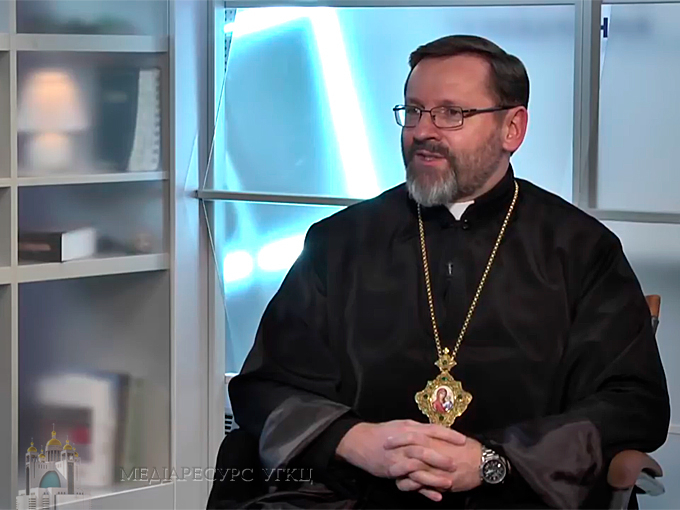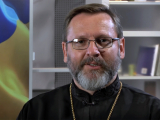Was the so-called Lviv sobor of 1946 really a church council?
Tuesday, 09 March 2021, 16:03 In the program "Live with His Beatitude Sviatoslav," dedicated to the sad anniversary of the proclamation of the "liquidation of the union" at a meeting in Lviv on March 8-10, 1946, the Head of the UGCC explained whether this event could be considered a church council at all. Here are his arguments.
-
See also:
- "I ask you to be worthy ambassadors of your homeland", the Head of the UGCC to those who were forced to leave Ukraine
- The head of the UGCC expresses his condolences over the repose of Bishop Emeritus Robert Moskal
- Today Russia is again committing a sin of Svyatopolk the Accursed, - The Head of the UGCC on the day of commemoration of Saints Borys and Hlib
Lviv "sobor" was not convened by the church authorities
Each council is convened by the church authorities. There must be a corresponding canonical act - a decree of the Head of the Church to convene a council. In the case of the Lviv pseudo-sobor of 1946, we see that this is an event that was completely orchestrated by the secular authorities and their special services. Even more, almost a year before the organization of this meeting, on the night of April 11-12, 1945, our entire episcopate in Ukraine, headed by Metropolitan Josyf Slipyj, was arrested. But at the time of this meeting, they were all bishops, although they were being tortured in prison. In case of his forced absence, each bishop left his administrators or vicars in his eparchy. Thus, although the hierarchs themselves could not freely perform their archpastoral duties, the canonical church structure and authority remained. None of those who legally carried out the archpastoral government convened any meeting and probably did not attend it.
The participants of the "sobor" did not represent their communities
Secondly, it should be noted that this meeting did not represent anyone. In order for a delegate to become a legitimate member of the council, he must be authorized by his community. After all, the Church is a community, and its delegates act on behalf of the parish, deanery or eparchy. Instead, none of the participants in the 1946 meeting in Lviv was authorized by any community. The 216 delegate priests represented only themselves and no one else.
The "sobor" was conducted by the "initiative group," not by the leadership of the UGCC
Next: who chaired this meeting? The "initiative group" was a structure parallel to the church hierarchy, created by the KGB and sanctioned by the Soviet state authorities. That is, we are talking about a kind of fake church organization, which at the time of the Lviv pseudo-sobor had no canonical relation to the Greek Catholic Church.
Father Havryil Kostelnyk and several of his supporters were officially admitted to the Orthodox Church in February 1946, and Fathers Melnyk and Pelvetsky were ordained bishops of the Russian Orthodox Church. That is, they could not speak on behalf of the Ukrainian Greek Catholic Church: neither as delegates to the council, nor as its presidium.
The decisions of the pseudo-sobor were not accepted by the people
Finally, I think it's just as important for us to keep that in mind. This type of meeting has not found a reception among the people. After all, the decisions of every church council, even if it is legally convened and held, must be accepted by the ecclesial community. And we see that the UGCC did not cease to exist, but continued to operate in prisons, in exile, in the underground.
Some of the believers were forced to belong to visible, legal forms of organization of church life. But as the events of the late 1980s showed, most of the priests and the faithful enjoyed religious freedom and returned to their Church. So, as we can see, the reception of the decisions of this pseudo-sobor did not take place.
Conclusion
Thus, it can be argued that by the nature of the convening of the Lviv pseudo-sobor in 1946, its representation and leadership, it had no signs of a canonical church meeting. It was a Soviet instrument for the liquidation of the Ukrainian Greek Catholic Church. It is very important to realize that, de facto, no "triumph of Orthodoxy" has taken place. Most of the fathers then withdrew their votes, and these were personal dramas of each person. Many were soon repressed by the Soviet authorities, even after serving as an Orthodox priest for some time. None of them had a guarantee of "reliability" in the eyes of the totalitarian and godless regime. Thus, this is a truly tragic event, the lessons of which we all in a modern independent and democratic Ukraine must learn so that this never happens again.
The UGCC Department for Information

We can imagine what the prayer of the prisoners in the Russian torture centers in the Ukrainian Kharkiv region was like – Head of the UGCC on the 206th day of the war 17 September
A vast cemetery, a mass burial, was found near the city of Izyum, in which more than 400 innocently killed and tortured people have already been...

